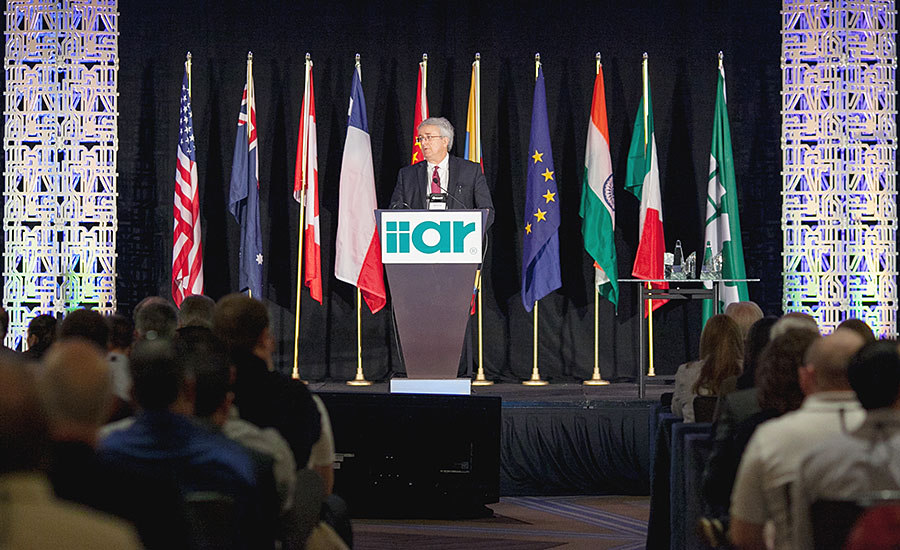
|
| TALKING NATURALS: IIAR outgoing Chairman Marcos Braz addresses IIAR members during the organization's 2015 business meeting. PHOTO COURTESY OF IIAR |
The world is moving toward natural refrigerants.
That was the message from the leadership of the International Institute of Ammonia Refrigeration (IIAR) at the 2015 IIAR Industrial Refrigeration Conference and Exhibition in San Diego.
“It’s an exciting time in our industry, a time of change,” said IIAR President Dave Rule. “As regulations and technologies evolve at a breakneck pace, we’re seeing new opportunities and applications like never before. We are truly an industry in transition.”
According to Rule, three central trends are having an impact on the business environment in the natural refrigerants sector. They are:
• Carbon-dioxide technologies. Long considered something of an outlier from a technology perspective, CO2 is moving into the mainstream and opening the door in new commercial arenas, such as supermarkets.
• Low-charge systems. These are expanding the natural refrigerants marketplace by introducing new industrial and commercial applications for ammonia.
• The phaseout of R-22 in the United States, and the broader F-gas phaseout underway in the European Union, both of which are starting to influence decision processes in the commercial and industrial markets.
“Propelled by regulatory change and environmentalism, and fueled by our industry’s relentless development of new, ever safer and more efficient technologies, an unmistakable trend has emerged: The world is moving toward natural refrigerants,” Rule said.
He added that IIAR’s primary mission is guiding the industry in standards development and code adoption. In the last year, the institute has made what Rule called “incredible progress” on the development of the comprehensive ammonia safety standard IIAR-2, and has begun working on two new standards: IIAR-4, which covers system installation, and IIAR-8, which covers system decommissioning.
NEW TOOLS AND SERVICES
IIAR has created or is in the process of creating several new member tools and services, including a dedicated website portal to deliver access to customized IIAR information and resources to the end-user community; a regulatory website portal to provide easy access to essential industry standards, guidelines, and training materials; and a member app designed to facilitate easy access to technical publications and services.
Along with the new initiatives, the institute is continuing its strong commitment to advocacy and education. IIAR has recommitted to a five-year formal alliance with the Occupational Safety and Health Administration (OSHA), and IIAR’s government relations committee, working with the Industrial Refrigeration Consortium (IRC), has released an OSHA training webinar to expand the knowledge base of the regulatory community.
In addition, the institute this year began work in partnership with the Refrigerating Engineers and Technicians Association (RETA) to identify ways to grow the industry’s pool of new talent.
“By developing a community college-level curriculum that can be delivered by schools across the nation, we hope to prepare the next generation for a career in our industry with a core refrigeration program,” Rule said.
He concluded by noting that the organization is approaching 2,400 members and tracking at a growth rate of 5 percent over the last year.
INTERNATIONAL INITIATIVES
IIAR Chairman Marcos Braz said the organization’s international initiatives are taking off.
Attendance at IIAR’s international technical seminars continues to expand, and in January IIAR unveiled a new effort to develop a network of international chapters. The institute has formed its first international chapter in Costa Rica, and is working with a number of IIAR members in Central America, China, and India who have expressed interest in forming an IIAR chapter.
“Through these international chapters, IIAR will be able to more effectively deliver the technical resources and publications the rest of the world is looking for, and start to influence ammonia safety standards, code development, and legislative activity in new arenas outside the United States,” Braz said.
Bob Port, IIAR’s Ammonia Refrigeration Foundation (ARF) chairman, said the ARF endowment has increased to $2.1 million, reaching the 60 percent mark in its goal to achieve an endowment of $3.5 million over the next three years.
“ARF funding levels are now capable of supporting a steady stream of important research projects,” Port said. “We’re well into the planning and development of these projects, and I expect that ARF will start turning out new research at a level we haven’t seen in past years. At the same time, we’ve identified our scholarship program as the main area of focus in the coming year, and have formed a new scholarship subcommittee to identify and pursue partnerships with educational institutions.”
Other notable announcements at the 2015 IIAR Industrial Refrigeration Conference and Exhibition:
• Tim Facius, ARF executive director, was honored with the IIAR Member of the Year Award.
• Five members were named to the institute’s board of directors: Martin Timm of Praxair for second term end user, Mike Chapman of Tyson Foods for first term end user, Dave Malinauskas of Cimco Refrigeration for first term contractor, Jeremy Klysen of Leo A. Daly for first term engineer, and Mike Lynch of U.S. Cold Storage for executive committee treasurer.










